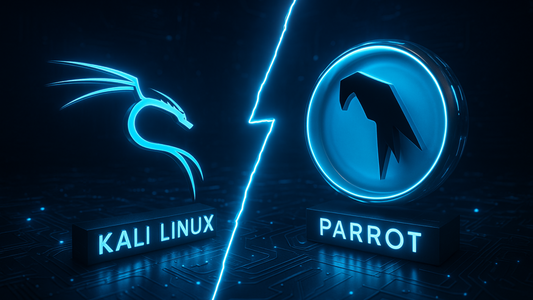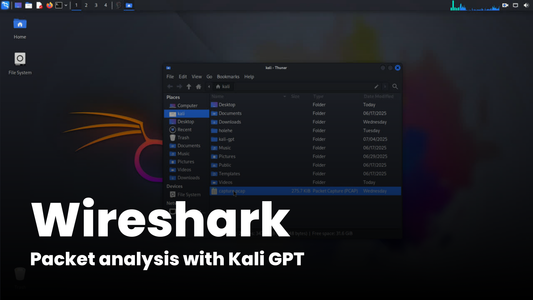
Kali Linux vs Parrot Security: Complete Comparison for Beginners
Share
Kali Linux vs Parrot Security: Complete Comparison for Beginners
When stepping into the world of cybersecurity and ethical hacking, choosing the right operating system is crucial. Two distributions stand out as the most popular choices: Kali Linux and Parrot Security OS. Both are powerful, feature-rich platforms designed specifically for security testing and penetration testing, but they cater to different needs and skill levels.
In this comprehensive guide, we'll break down the key differences between Kali Linux and Parrot Security OS to help you make an informed decision that aligns with your cybersecurity goals.
What is Kali Linux?
Kali Linux is a Debian-based Linux distribution specifically designed for digital forensics and penetration testing. Developed and maintained by Offensive Security, it's the successor to BackTrack and has become the de facto standard for ethical hackers and security professionals worldwide.
Key Features of Kali Linux:
- Over 600 pre-installed security tools
- Rolling release model with regular updates
- Support for multiple architectures (x86, ARM, etc.)
- Extensive documentation and community support
- Industry-standard tool collection
- Optimized for security testing workflows
What is Parrot Security OS?
Parrot Security OS is a GNU/Linux distribution based on Debian and designed with security, privacy, and development in mind. Created by Lorenzo Faletra (Palinuro) and his team, it offers a more user-friendly approach to penetration testing while maintaining powerful security capabilities.
Key Features of Parrot Security OS:
- Lightweight and resource-efficient
- Privacy-focused with anonymization tools
- User-friendly interface suitable for beginners
- Regular security updates
- Multiple editions (Security, Home, Architect)
- Strong emphasis on digital privacy
Head-to-Head Comparison
1. User Interface and Experience
🐉 Kali Linux:
- Uses XFCE as the default desktop environment
- Minimal, functional interface focused on efficiency
- Steeper learning curve for beginners
- Command-line heavy workflows
- Customizable but requires technical knowledge
🐦 Parrot Security OS:
- Uses MATE desktop environment by default
- More polished, modern interface
- Beginner-friendly with intuitive navigation
- Better out-of-the-box experience
- More visually appealing for desktop use
🏆 Winner: Parrot Security OS for beginners, Kali Linux for experienced users
2. System Resources and Performance
🐉 Kali Linux:
- Minimum RAM: 2GB (4GB recommended)
- Disk space: 20GB minimum
- Moderate resource consumption
- Optimized for performance over aesthetics
🐦 Parrot Security OS:
- Minimum RAM: 1GB (2GB recommended)
- Disk space: 16GB minimum
- Lower resource consumption
- Better performance on older hardware
🏆 Winner: Parrot Security OS for resource efficiency
3. Tool Collection and Availability
🐉 Kali Linux:
- 600+ pre-installed security tools
- Comprehensive tool coverage
- Industry-standard tool selection
- Regular tool updates and additions
- Extensive tool documentation
🐦 Parrot Security OS:
- 400+ pre-installed security tools
- Curated tool selection
- Focus on quality over quantity
- Easy tool installation and management
- Good tool documentation
🏆 Winner: Kali Linux for tool variety and industry standards
4. Learning Curve and Beginner-Friendliness
🐉 Kali Linux:
- Requires solid Linux knowledge
- Steep learning curve
- Excellent for skill development
- Comprehensive documentation
- Strong community support
🐦 Parrot Security OS:
- More beginner-friendly
- Gentler learning curve
- Better for Linux newcomers
- Good balance of power and usability
- Supportive community
🏆 Winner: Parrot Security OS for beginners
5. Privacy and Anonymity Features
🐉 Kali Linux:
- Basic privacy tools included
- Tor browser available
- Focus on security testing rather than privacy
- Manual privacy configuration required
🐦 Parrot Security OS:
- Built-in anonymization tools
- Tor integration out-of-the-box
- Strong emphasis on digital privacy
- Privacy-focused by design
- Better for anonymous operations
🏆 Winner: Parrot Security OS for privacy features
6. Community and Support
🐉 Kali Linux:
- Large, active community
- Extensive documentation
- Regular tutorials and guides
- Strong corporate backing (Offensive Security)
- Industry recognition
🐦 Parrot Security OS:
- Growing community
- Good documentation
- Active development team
- Responsive support forums
- Less corporate backing
🏆 Winner: Kali Linux for community size and support
Which Should You Choose?
Choose Kali Linux if:
- You're serious about becoming a penetration tester
- You have solid Linux experience
- You need industry-standard tools and workflows
- You're pursuing cybersecurity certifications
- You want the most comprehensive tool collection
- You're comfortable with command-line interfaces
Choose Parrot Security OS if:
- You're new to cybersecurity and Linux
- You prefer a more user-friendly interface
- You have limited system resources
- Privacy and anonymity are priorities
- You want a gentler introduction to security testing
- You prefer a more modern, polished desktop experience
Getting Started Tips
For Kali Linux Beginners:
- Start with the official Kali Linux documentation
- Practice basic Linux commands first
- Use virtual machines for safe learning
- Join the Kali Linux community forums
- Consider pairing with AI assistants like Kali GPT for guidance
For Parrot Security OS Beginners:
- Explore the user-friendly interface first
- Take advantage of the built-in tutorials
- Start with basic security tools
- Join the Parrot community on social media
- Practice in isolated environments
Conclusion
Both Kali Linux and Parrot Security OS are excellent choices for cybersecurity enthusiasts, but they serve different purposes and audiences. Kali Linux remains the industry standard with its comprehensive tool collection and professional focus, making it ideal for serious penetration testers and security professionals.
Parrot Security OS offers a more accessible entry point into cybersecurity with its user-friendly interface and privacy-focused features, making it perfect for beginners and those prioritizing digital privacy.
Remember, the best distribution is the one you'll actually use and learn from. Consider starting with Parrot Security OS if you're new to the field, then potentially transitioning to Kali Linux as your skills develop.
Whichever you choose, consistent practice and continuous learning are key to success in cybersecurity. Consider leveraging AI-powered tools and assistants to accelerate your learning journey and maximize your productivity with either platform.
Ready to supercharge your cybersecurity journey? Discover how Kali GPT can enhance your experience with Kali Linux and help you master penetration testing faster and more efficiently.



